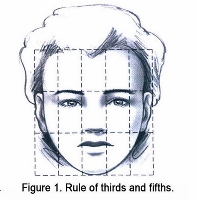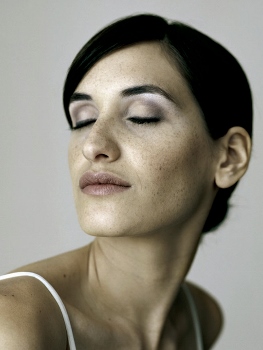02 Jan Defining attractiveness, proportion, symmetry
Beauty is much more than skin-deep and often in the eye of the beholder. Facial plastic surgeons propose that the contours and dimensions of the underlying bone structure affect proportion, symmetry, averageness, and gender norms?these factors come together to determine your attractiveness.
If you divide the face into equal thirds (figure 1) with horizontal lines drawn through the forehead hairline, the brow, the base of the nose, and the edge of the chin, a well-proportioned face will fall within these guidelines. Vertically, if you divide the face into fifths?approximately the width of one eye?the facial features should fit within these parameters. Sometimes one element may fall outside of what is average, but still may be attractive if balanced by other facial features. For example, prominent cheekbones, as seen on many fashion models, may balance a prominent lower jaw.
No face is pe rfectly symmetric, and most minor differences often go unnoticed. The more significant the differences in the two sides, the more distracting and diminishing of attractiveness. Make-up can camouflage minor variances. Surgery may be required to improve major variations.
rfectly symmetric, and most minor differences often go unnoticed. The more significant the differences in the two sides, the more distracting and diminishing of attractiveness. Make-up can camouflage minor variances. Surgery may be required to improve major variations.
Averages have long been used by surgeons to guide reconstructive procedures, e.g., using averaged measurements from databases of facial dimensions. Recent studies have also proven that averageness is an important factor in defining beauty. Dr. Kang Lee and Dr. Pam Pallett found that the more average a face is, the more appealing it is. As the brain processes faces throughout the day it is constantly creating an average representation of all the faces. This causes us to prefer to look at something that is average. Another study used computer imaging to average the faces of various population groups. Participants rated the “averaged” images more attractive than the individual faces within the pool that created the composite. Most patients recognize that extreme changes to their visage isn’t the best option; instead, it is about enhancing and rejuvenating what you already have that precipitates the best outcome.

Gender-specific traits also play a role. There are significant differences between men and women. Ratios and balance are different. Women tend to have narrower faces, fuller lips, higher cheekbones, softer jawlines, more arched eyebrows, and shorter-shaped noses, to name just a few. The more feminine a woman’s attributes are, the more attractive she is perceived to be. Make-up is used to highlight key features; the more contrast between your eyes or lips and the surrounding area the more feminine it appears. A study in France proved that waitresses wearing red lipstick received bigger tips. Beyond make-up, there are noninvasive treatments such as fillers that provide temporary improvements or surgical options?e.g., lip augmentation, cheek and chin implants?that offer lasting results.
Attractiveness is dependent on the harmonious relationship of your facial features. How comfortable do you feel with your appearance? Consult Dr. Edds to discuss ways to enhance your beauty?from make-up techniques and minimally invasive treatments to cosmetic and reconstructive surgery.


